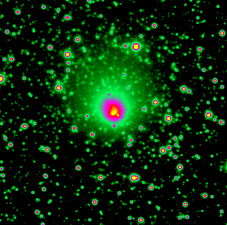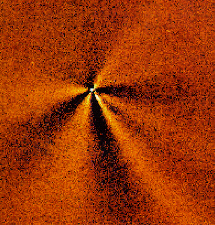ING OBSERVATIONS OF COMET HALE-BOPP
 Comet
Hale-Bopp was discovered at a heliocentric distance of 7.2 AU in July 1995.
What was significant about this discovery was both the large distance at
which it was discovered, and that it was already at an integrated magnitude
of ~10.5. To put this into context, at the same distance from the Sun Comet
Halley was at V=22.8. This difference was mostly due to the fact that Hale-Bopp
had generated an atmosphere, or coma, around itself, while Halley had not.
At such large distances the optical coma of a comet is dominated by scatered
sunlight from dust grains. These are released from the comet nucleus (generally
1–20 km in diameter) through sublimation of surface ices, at this distance
primarily volatiles such as CO. Therefore the presence of so much dust
implied an extremely active nucleus, with either a large fraction of its
surface undergoing outgassing, or perhaps just a very large nucleus.
Comet
Hale-Bopp was discovered at a heliocentric distance of 7.2 AU in July 1995.
What was significant about this discovery was both the large distance at
which it was discovered, and that it was already at an integrated magnitude
of ~10.5. To put this into context, at the same distance from the Sun Comet
Halley was at V=22.8. This difference was mostly due to the fact that Hale-Bopp
had generated an atmosphere, or coma, around itself, while Halley had not.
At such large distances the optical coma of a comet is dominated by scatered
sunlight from dust grains. These are released from the comet nucleus (generally
1–20 km in diameter) through sublimation of surface ices, at this distance
primarily volatiles such as CO. Therefore the presence of so much dust
implied an extremely active nucleus, with either a large fraction of its
surface undergoing outgassing, or perhaps just a very large nucleus.
 Subsequent
spectrophotometry with the WHT a month after discovery revealed the presence
of the CN molecular band, formed from the HCN being released from the nucleus
and then being photo-dissociated via solar UV photons. Monte-Carlo modelling
of these data revealed an outgassing rate for the parent HCN molecule of
6e25 mol./second. This confirmed the high activity of the nucleus, as Halley
had an outgassing rate a factor of 10 lower when it was at 4.5 AU from
the Sun. This meant that the discovery of Comet Hale-Bopp at an unusually
large heliocentric distance provided an unprecedented opportunity to follow
its evolution from beyond Jupiter into the inner Solar System. To take
advantage of this, spectroscopic follow-up was carried out using variously
the WHT with ISIS and the INT with the IDS. A spectrum of the comet was
obtained on 3 September 1996. Even though the comet was still 3.2 AU from
the Sun, where most comets show little activity, Hale-Bopp had a spectrum
tremendously rich in molecular species.
Subsequent
spectrophotometry with the WHT a month after discovery revealed the presence
of the CN molecular band, formed from the HCN being released from the nucleus
and then being photo-dissociated via solar UV photons. Monte-Carlo modelling
of these data revealed an outgassing rate for the parent HCN molecule of
6e25 mol./second. This confirmed the high activity of the nucleus, as Halley
had an outgassing rate a factor of 10 lower when it was at 4.5 AU from
the Sun. This meant that the discovery of Comet Hale-Bopp at an unusually
large heliocentric distance provided an unprecedented opportunity to follow
its evolution from beyond Jupiter into the inner Solar System. To take
advantage of this, spectroscopic follow-up was carried out using variously
the WHT with ISIS and the INT with the IDS. A spectrum of the comet was
obtained on 3 September 1996. Even though the comet was still 3.2 AU from
the Sun, where most comets show little activity, Hale-Bopp had a spectrum
tremendously rich in molecular species.
While the gradual brightening of the
comet is clear, any short-term variability in the dust production, and
hence outgassing, rate is difficult to obtain from these observations.
Therefore in August 1996 CCD imaging of Hale-Bopp was obtained with the
JKT over 13 nights, with the primary goal being an investigation into the
short-term (hours–days) variability of the comet. By fitting the comet
images with a modelled isophote distribution and subtracted it to reveal
more clearly the underlying structure, a similar process to that used in
the study of shell galaxies, it is possible to study the morphology of
the coma. On 27 August 1996 comet Hale-Bopp was imaged with an R-band filter
in seeing of 0.6 arcseconds using the JKT. Six well defined jets were seen
emanating from the nucleus. These were due to the outgassing from the nucleus
being confined to several localised hotspots, where the insulating mantle
was thin or non-existent thereby allowing heating of the nuclear ices.
| More
information
ING facilities involved:
-
WHT+ISIS
-
INT+IDS
-
JKT+CCD imaging
Pictures:
Some references:
-
A Fitzsimmons and I M Cartwright,
1996, "Optical spectroscopy of comet C/1995 O1 Hale-Bopp", MNRAS,
278,
L37
-
A Fitzsimmons et al, 1996,
IAU
circular 6361
-
A Fitzsimmons et al, 1996,
"ING observations of Comet Hale-Bopp", Spectrum Newsletter, 12,
4
|

